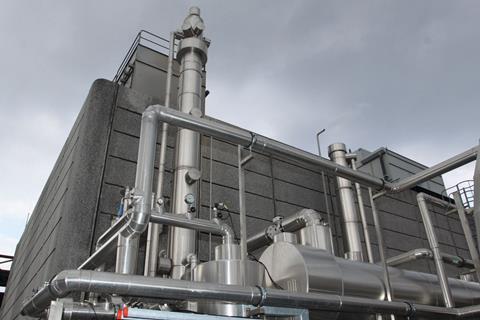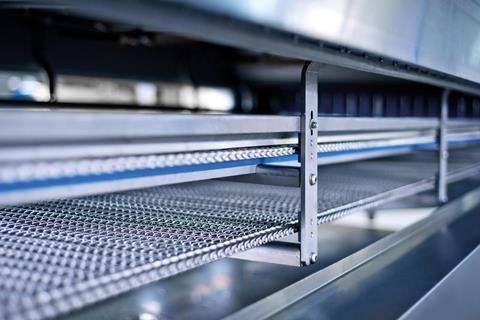

The food and beverage industry has enjoyed the benefits of using industrial gases and technologies for decades, improving food quality, preservation and safety in increasingly intricate ways.
Gases such as oxygen, nitrogen, argon, nitrous oxide, hydrogen and carbon dioxide (CO2) have long been used to chill, freeze and package foods including fruit and vegetables, meat, seafood and bakery products. But its application of these gases and the technologies to support them is constantly evolving.
This In Focus… will explore three key applications in the food and beverage sector and the latest trends shaping them.
MAP
Modified atmosphere packaging (MAP) is one of the most updated options to traditional packaging technologies and involves removing and replacing the atmospheric gases with a pre-determined gas mixture to slow down the product aging process and preserve the fresh colour, taste and nutrient content throughout an extended shelf life.
The three main gases used in this process are oxygen, CO2 and nitrogen. The choice of gas, or mixture of gases, is very dependent upon the food product being packed.
The expectation of modern consumers that all kinds of goods are always available in good quality and at cheap prices has driven the introduction and development of MAP over the years.
Foodstuff producers also have the desire to make their foodstuff available to as many consumers as possible and in the same fine quality as when it was manufactured.
“These demands mean that there will be a need for a wider distribution of the product which in turn will prolong the transportation time in which the product is to maintain its freshness and quality,” explained MOCON Europe’s Sales Manager Morten Torngaard.
“Other factors include food safety, a desire to minimise artificial preservatives, and a high focus on the reduction of wasting food and packing materials.”
Studies show that the use of MAP technology has been growing for many years and will continue to grow for the coming years. Average annual rates for MAP are expected to be 4-5% over the next five years. In emerging markets, for example the Asia-Pacific region, growth rates are expected to be closer to 7%.
The use of MAP is finding its way in to more and more applications and more market segments. With this growth in mind, producers and consumers want to know now more than ever as much information about the food product as possible, such as where it came from, when it was packed and expected shelf life. “There seems to be a high focus and demand for collecting storing data. This enables producers to improve their productivity and offer improved quality, as well as extended traceability to the customer,” Torngaard noted.

Source: Pentair Union Engineering
Brewing
Improved quality and productivity, as well as sustainability of supply, are driving developments in the brewing and beverages side of the market too.
For the past decade, global multiple- brand owner Pentair has invested in businesses and brands with strong positions and technologies within food and beverage. The company has established strategic business units for this industry, including:
• Pentair X-Flow - develops filtration that delivers high efficiency and lowest total cost of ownership. The membranes are utilised within both breweries, dairy and food industries
• Pentair Haffmans - supplies quality control equipment, micro-filtration and CO2 and oxygen management. With optical oxygen measuring technology, the oxygen quality and CO2 purity is monitored during the complete process of CO2 recovery, starting at the intake of CO2 down to efficient removal of impurities and ultra-low oxygen contents after the bulk CO2 tank and beyond
• Pentair SGS (Sustainable Gas Solutions) - cover the two CO2 plant designers Pentair Haffmans and Pentair Union Engineering. Both brands supply CO2 recovery solutions for breweries as well as biogas upgrading technology, both membrane and amine based. Further to the broader scope, Pentair Union Engineering is holding a wide range of patented solutions for the industrial gas industry as well as solutions for desalination and soft drink bottlers.
The company cites sustainability of supply as one of the major areas of improvement – and growth – in the food and beverage industry as Dr. Uwe Kikillus explained, “Sustainability is an area that will still grow. Efficient production is the key to feed the world and to utilise the raw materials efficiently with a minimum of waste.”
“We also experience a rising interest in investing in biogas solutions in the food and beverages utilising the waste. This is a next level in the circular economy – closing the loop is purifying the CO2 from the upgraded biogas and utilising it in the food and beverages – a solution some have implemented.”
“Here we have examples from both UK, Netherlands and the first-of-its-kind in under construction in Denmark – delivered by Pentair Union Engineering and installed for industrial gas company Strandmøllen at the large biogas plant Korskro in Denmark.”
Pentair Union Engineering has developed and implemented a range of technologies in the last half-decade. In 2013, it introduced the first ever water free CO2 technology for breweries, named ECO2Brew. This technology has been improved and is now introduced as an ECO2Brew 2.0 version for the true environmental conscious breweries. As an example, when a 1,000 kg/hr CO2 plant is required the annual amount of water savings are approximately 4,500m3 of drinking water.
In 2018, Pentair Union Engineering launched a groundbreaking project together with Swiss-based company Climeworks, following a research and development project supported by EU project called CAPDrinks. This project enables the utilisation of ambient air for production of foodgrade CO2 for different purposes. This first project is focusing on the soft drink business.
Digitisation is another hot topic in the beverages business and wider food sector. The Internet of Things (IoT) is high focus area for Pentair. “For decades, we have offered remote service for the CO2 plants we install. As a standard all CO2 plants are equipped with an Ewon router and in case needed and wanted from customers side, we can log on and identify problems before they occur or costs a lot of stoppages and service,” Kikillus said. “Recently we have also introduced IoT to breweries with a focus on efficient and optimised production.”

Tunnel-inside_Dohmeyer
Source: Dohmeyer
Chilling and freezing
Food chilling and freezing use cryogenic industrial gases such as liquid nitrogen (-196°C) and liquid carbon dioxide (-79°C). Because of the extremely cold temperatures of these liquids, food can be frozen within minutes instead of the hours required by conventional systems.
This fast freeze provides numerous food quality benefits through the formation of smaller ice crystals, which causes less damage to a product’s cellular structure. This allows food to maintain moisture, which not only improves texture, colour, and flavour, but also translates into smaller weight loss from dehydration.
Over the last two decades, freezing specialist Dohmeyer has cemented itself as a leading manufacturer of cryogenic refrigeration systems, continuing to develop innovative chilling and freezing solutions specialised in cabinet, in-line tunnel, immersion and spiral freezers.
With an industry background rooted in Cryogenic Engineering Design and Food Processing, Vice-President of Sales Danny t’Kindt understands the interaction between the products and their optimum cryogenic freezing techniques. The company continuously monitors market trends and talks to its customers to innovate, improve and modify its equipment range. New for 2019, Dohmeyer will be launching a range of temperature controlled blenders and mixers.
“Designed and manufactured with either liquid carbon dioxide or liquid nitrogen bottom injection nozzles already fitted, these blenders will provide full process control for the end-user. No longer will the injection nozzles be a retrofit, the blending and temperature control systems, provided by one single supplier, are designed to work together from the start,” t’Kindt explained.
He said the primary trend Dohmeyer is noticing is upscaling, “We are frequently being asked to provide equipment capable of increased production rates. In terms of products there remains a strong requirement for IQF (Individually Quick Frozen) and convenience foods.”
With changing consumer habits, and more advanced technologies, chilling and freezing applications are evolving so that the gases are utilised to enhance food during the preparation stage of further processed food. Instead of just freezing the product prior to packaging, the food industry now utilises a cryogenic gas to chill the product so that it forms consistently.
Whether it’s a differentiation in the initial temperature of the product from a customer stand-point or a variation in the batch size, manufacturers can utilise the gas to chill the ingredients so that once it’s formed into a patty, nugget, or meatball for instance, it’s formed consistently and there’s minimal to no variation. Additionally, the number of marinated products is increasing more and more each year. Whether it’s a stitch marinade or a tumble marinade, more processors are adding a seasoned liquid solution to improve quality, texture and taste.
Mark DiMaggio, Head of Applications & Marketing for Linde America, clarified, “What we’re able to do at Linde is maximise the amount of retention of a marinade utilising our patented technologies, prior to even freezing the products for final packing which results in increased yield and value. We are now involving our gases and applications along the processing line, from the time that the animal or ingredient comes in the door, all the way up to and including final packaging.”
“We aren’t just freezing for preservation, for accurate chilling, or to hold a product in a modified atmosphere anymore. The boundaries are unlimited in terms of how to utilise these gases and application technologies to improve quality, increase production capacity and extend product shelf life.”
Also trending…
In closing, Pentair Union Engineering reflected on other, wider trends in the food and beverage business, from safety to commodity reductions and of course, digitisation. “The trends driving the food and beverage industry are food safety, utility savings and an increased need for being self-supplied within CO2,” Kikillus said.
“Food safety is an area that has been in focus for the past five to 10 years and will still be going forward. The ongoing investments in quality controls is confirming this.”
“With regards to utility savings, any player within this industry has a CSR strategy and a serious focus on saving on utilities like water usage and electricity and chemical savings.”
“The CO2 shortage we have seen for the past two summer seasons has created an increased need for being self-supplied within CO2, which is a low-hanging fruit especially for breweries. Where a stack gas is available for extracting CO2 from the flue gases also the soft drink bottlers and other can benefit from this opportunity.”
Does Pentair think digitisation will change the food and beverage industry in the future? “We think in general more accurate data, more efficiency and easier following up,” Kikillus said.
This was echoed by t’Kindt, “Ease of access to information and the ability to react and influence is key, this can be through real time reporting of how production machinery is performing and being able to adjust and alter settings to suit. Or simply availability of details on the capability of applications equipment for design of new production lines.”
“What is currently seen as an additional function or feature will become the expected norm. With information shared up and down the supply chain controlling production, storage and distribution.”